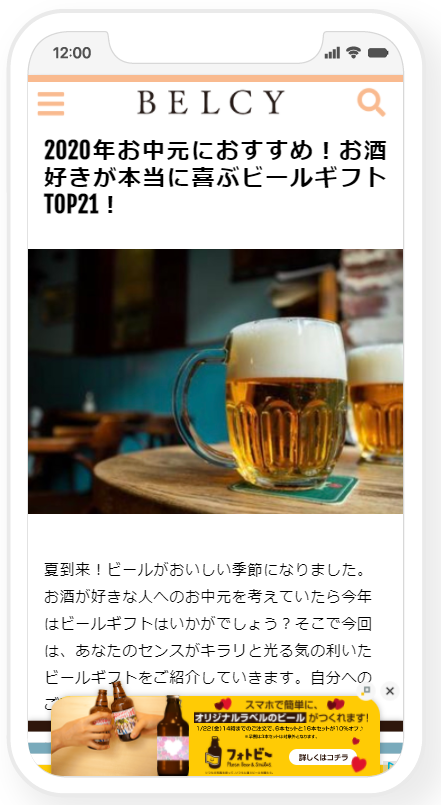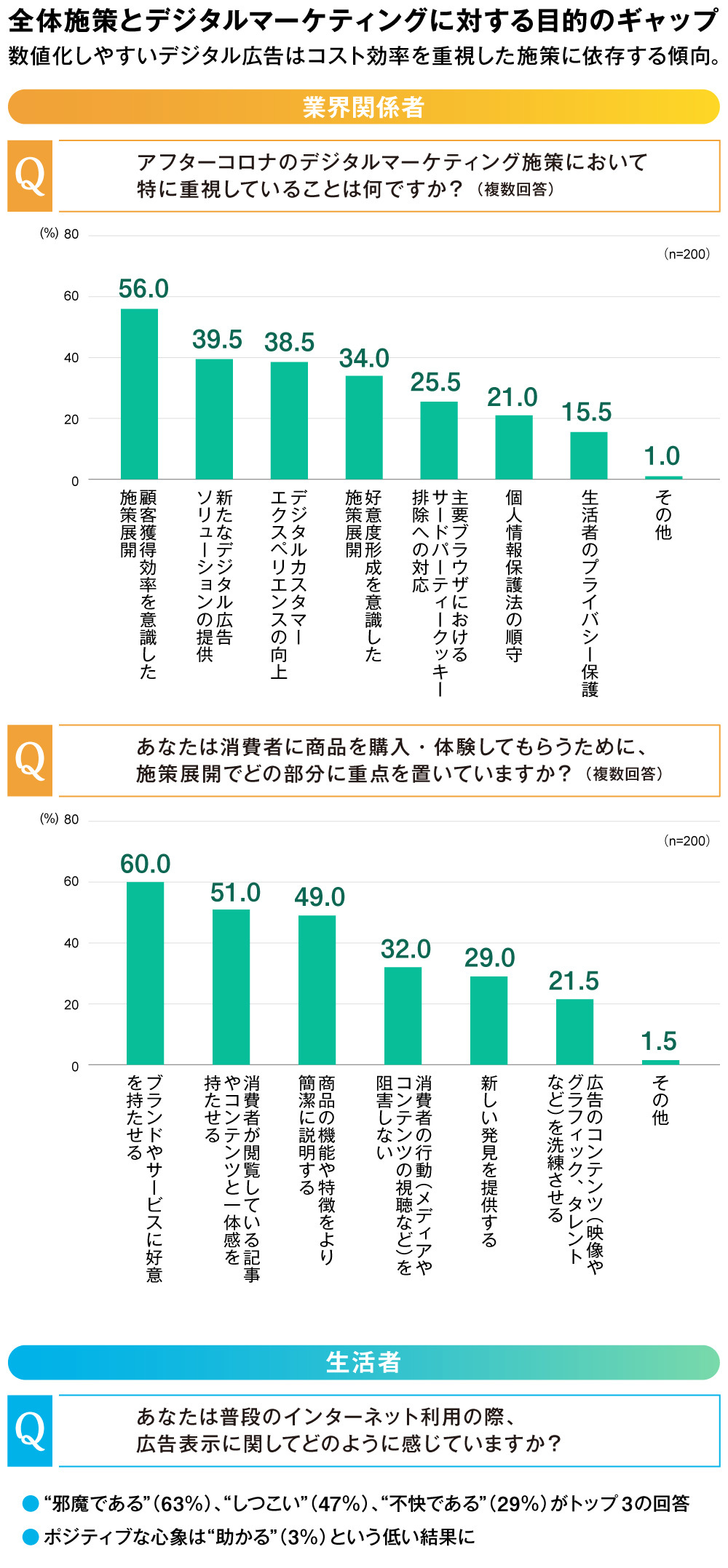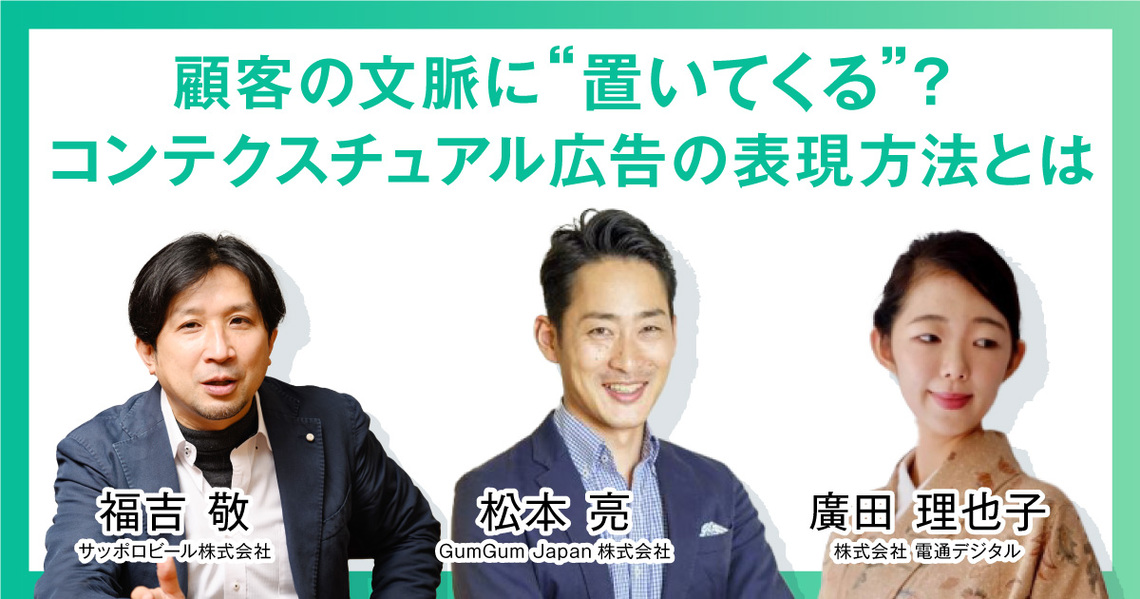
Click
here to see the actual delivered creative
This series explores the potential of "contextual advertising" (※1), a new trend in digital advertising for the cookie-free era.
Following our previous installment, which explained its groundbreaking nature and usefulness based on the efforts of GumGum Japan, a top runner in contextual advertising, this time we delve into the appeal of contextual advertising through concrete corporate case studies.
We welcomed Sapporo Breweries' Takashi Fukuyoshi as a guest, joined by GumGum Japan's Ryo Matsumoto and Dentsu Digital Inc.'s Riyako Hirota for a discussion.
*1 Contextual Advertising
A programmatic advertising format that analyzes context (contextual analysis) to display ads on media and content matching the brand, reaching consumers well-suited to that brand. (Also known as: Contextual Advertising / Content-Targeting Advertising)
Shifting from "Advertising Driven by Corporate Needs" to "Advertising That Aligns with Customer Context"
Matsumoto: Mr. Fukuyoshi, while handling much of the content communication at Sapporo Breweries, you've been tackling "context-aware initiatives" from quite an early stage. How do you perceive the term "context," which has recently taken on a life of its own as a sort of buzzword?
Fukuyoshi: Context encompasses many things, so it's difficult to interpret simply. I believe it's composed of a combination of affinity (interests), moment (timing), and generation (demographics).
Fundamentally, each person's interests differ. Even for the same person, moods shift between morning and night, Monday and Friday. There are also contextual differences between generations. Lately, work styles, parenting approaches, and how people spend their holidays have diversified, leading to increasingly varied consumer interests and mindsets. Isn't aligning with this "diverse context" what's demanded of advertising today?
Hirota: I agree. It's no longer an era where people of the same gender and age group all aspire to the same products or lifestyles. I feel the need for "context creation" – delivering ads at the "Right time, Right message, Right place" – is growing.
Matsumoto: I also sense that precisely because modern people have so many more choices, they tend to perceive information that doesn't resonate with their personal context as noise and shut it out immediately. This highlights the growing necessity to understand the "context of the information receiver," not just the "convenience of the information sender," as was common in traditional mass advertising.
Fukuyoshi: Before smartphones became widespread, when ads designed to create convenient contexts from a corporate perspective were highly effective, the variety of entertainment and the amount of information customers encountered daily weren't nearly as vast.
Take beer as an example. Back then, consumers tended to stick to certain brands, and mass communication focused on reach worked well by fitting people into demographic molds like "This is what 30-something men want!" But times have changed. Smartphone adoption transformed every aspect of lifestyle, making one-size-fits-all approaches based on demographics alone no longer effective.
We often see ads that have nothing to do with the content we're currently viewing, appearing out of context. I believe that with such traditional methods, we cannot create "beloved ads" for our customers.
Matsumoto: I see. What does Sapporo Beer focus on to create "beloved ads"?
Fukuyoshi: It's putting "customer happiness" first. Starting with what customers want, what interests them, and what makes them happy, the advertiser adapts to each individual customer's "context." In other words, instead of targeting or clustering based on "what the company wants to say," we focus on understanding the customer persona ( ) and consider what we can communicate within each individual's context.
Customer-centricity is key to designing KPIs for contextual advertising
Matsumoto: I completely agree on that point. Our contextual advertising is often seen as a "substitute for programmatic advertising in the post-cookie era," but its true purpose isn't necessarily that. It's meant to lift brand awareness by displaying the right creative at the right moment for that specific customer.
However, according to a survey GumGum conducted with advertisers, we found that when considering overall strategy, they prioritize "building brand or service affinity" above all else. Yet, when focusing on digital, they tend to place the highest importance on "deploying strategies with customer acquisition efficiency in mind."

Excerpt from GumGum survey. See
article end for survey details.
Matsumoto: So, even though the overall strategy starts firmly from a "customer-centric" perspective, for some reason, the moment it shifts to digital, it tends to become "company-centric." What are your thoughts on this, Hirota-san, who supports GumGum's sales at Dentsu Digital Inc.?
Hirota: I agree with you, Matsumoto-san. I feel that especially in Japan, the tendency to "prioritize performance in digital advertising" remains strong even now. When I spoke with GumGum's U.S. team, their headquarters, I learned that in the U.S., they place greater emphasis on "achieving the overall KPI for the campaign" rather than performance on individual media channels. Furthermore, the focus of that KPI is on "whether it contributed to enhancing brand value."
Of course, there are differences in advertising budget scale and culture between the US and Japan. However, even in Japan, I believe we need to further demonstrate the potential of "digital advertising that contributes to in-store purchases." This includes scenarios where, even if it doesn't directly lead to user actions like e-commerce conversions, it influences behavior like "while at the supermarket, a consumer suddenly recalls a contextual ad they previously saw for Sapporo Beer and picks up the product."
Matsumoto: I see. In Europe and the US, there's a tendency to place greater emphasis on quality—whether digital advertising contributes to brand lift—rather than solely focusing on performance metrics. From your perspective, Fukuyoshi, how does this look from the advertiser's viewpoint?
Fukuyoshi: We also believe contextual advertising holds significant value precisely because it can deeply engage within the target's context and leave a lasting brand impression, even if it doesn't immediately lead to conversion.
Even without a specific target audience, traditional ads can be created simply by highlighting a product's USP (Unique Selling Proposition). Things like "increased malt content," "rich flavor," or simply "delicious." Of course, emphasizing the USP remains important. But the reality is we're moving toward a world where "just being delicious isn't enough to get chosen." We need to communicate, "This delicious product is meant for you." That's where the concept of context becomes crucial.
Matsumoto: Given that, how should we appropriately "evaluate" the success or failure of contextual advertising?
Fukuyoshi: We should think from the customer's perspective and measure how contextual advertising "brought customers closer to the brand" and "created entry points for customers to discover the brand."
Evaluation criteria include whether customers who saw the contextual ad "became fans over time" or "visited the brand site."
Then, set KPIs based on "what you aimed to achieve with that ad and whether it was accomplished." For example, if your goal is "getting 5,000 people to fully read content on the brand site," you can work backward from impression counts and bounce rates to establish clear goal metrics.
Furthermore, as mentioned earlier in Mr. Hirota's supermarket example, we should measure metrics like brand site visit rates more from an "attribution" perspective. In other words, measuring not just immediate reactions but from a medium-to-long-term viewpoint will become increasingly important going forward.
The key to contextual ad creative is the spirit of "omotenashi"
Matsumoto: So far, we've discussed evaluation metrics for contextual advertising. Mr. Fukuyoshi, who has always emphasized the concept of "context" in advertising, could you also offer advice on how to create advertising expressions?
Fukuyoshi: I often use the phrase "place it within the context." Rather than direct expressions like "This is the product," it's preferable to express it in a way that "places the product within the context."
For example, instead of content like "On Doyo no Ushi no Hi, enjoy Yebisu Beer with your eel!", we might create content asking "Do you know the origin of Doyo no Ushi no Hi?" to engage customers' interest. Then, subtly place Yebisu Beer in the corner of a photo showing delicious-looking eel. This aims to cultivate the desire to "drink Yebisu Beer with eel" when Doyo no Ushi no Hi arrives.
Also, while it's ideal for measuring the attribution mentioned earlier that users transition from the ad to the brand site, it's crucial that the brand site's presentation maintains consistency, including the content's context, story, and atmosphere.
Matsumoto: Hearing you talk just now, the word "omotenashi" came to mind. It's precisely like a high-end inn, meticulously designed to deliver a unified message from the entrance (the ad) to the exit (the brand site or in-store purchase experience).
Fukuyoshi: That might be because Sapporo Beer is a company that handles "luxury goods." We deliver enjoyment and entertainment that enrich life, not just necessities for survival. That's precisely why we believe it's vital to connect with our customers' feelings through the spirit of "omotenashi."
Matsumoto: Thank you for that very clear example. Finally, could you both share your expectations and requests regarding contextual advertising?
Fukuyoshi: We constantly analyze data to understand where our customers are and what they like. We see tremendous potential in content that can naturally blend into the "context" derived from this analysis.
Currently, the system works where "appropriate ads are displayed on the spot for articles or content the user has shown interest in and engaged with." Going forward, we'd love to see it take another step forward, enabling the targeting of content and creative based on factors like "time of day" or "location information."
As a consumer myself, it would be fantastic if, say, while browsing a gourmet site during a trip to Hokkaido, "Hokkaido gourmet information" appeared right away, or if I like Yebisu beer, "places in Hokkaido where you can drink Yebisu" showed up subtly (laughs). This can be done without ID information, so I think it's a strategy well-suited for the cookie-free era.
Hirota: Speaking for myself, I've noticed more people gathering information through videos and visuals lately. While animated display ads are currently the mainstay, I'm hopeful that expanding contextual advertising into video platforms and audio spaces like internet radio could open up a whole new world.
Matsumoto: We'll take everyone's passionate feedback to heart and push forward with development! Thank you all for today!
<Survey Overview>
Survey on Awareness of Privacy and Internet Advertising
1. Industry Professional Survey
・Survey Sponsor: GumGum
・Survey Implementation Agency: Seed Planning
・Survey Period: June 24 to July 15, 2021
・Survey Method: Online survey
・Respondent Criteria: Advertisers or Advertising Agencies
(Advertising Agencies / Media Representatives)
・Sample Size: 200 respondents
2. Consumer Survey
・Survey Sponsor: GumGum
・Survey Implementation Agency: INTAGE
・Survey Period: July 16–18, 2021
・Survey Method: Internet survey
・Respondent Criteria: Men and women aged 20–59
・Sample Size: n=1073











